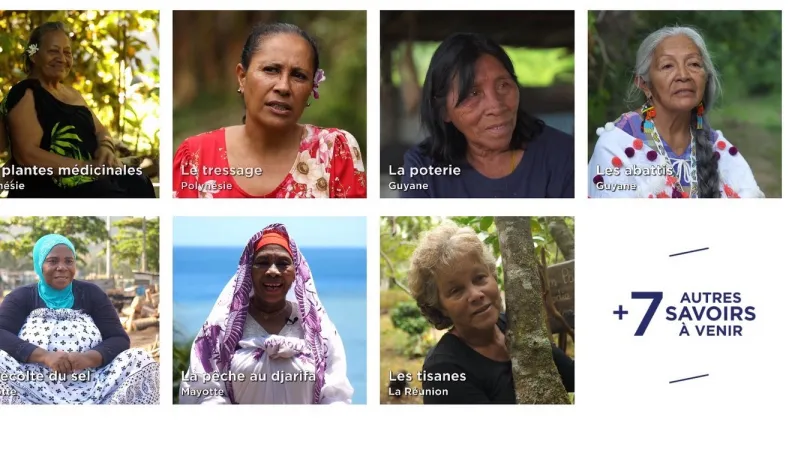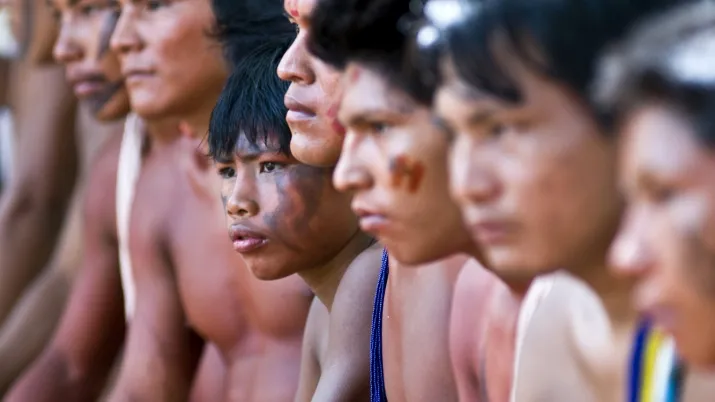Share the page
Passing Traditional Knowledge from Mother to Child, to Protect the Environment
Published on

Traditional knowledge passed on from mother to daughter can help future generations tackle the consequences of global warming, but such knowledge is in danger of being lost. On International Women's Day, we look at the project “De la Mère à la Terre” (from Mother to Earth), which highlights the work these women are doing to protect the environment, and the obstacles in their way.
“Weaving is also about bonding,” says Maureen Taputu, a self-employed weaver. “It’s an umbilical cord. I’m fortunate to have a mother who has all these skills and to have learned them over the years.”
In Rurutu, in the Polynesian Austral Islands, women are specialists in weaving leaves from the tropical plant pandanus and bamboo. Weaving is a practice passed down from mother to daughter and an intrinsic aspect of the identity of Polynesian people.
Maureen’s grandmother, then her mother, Tiaré, taught her weaving techniques from an early age. She’s now passing on this knowledge to a 16-year-old girl in the village, Tuaaneanau, who’s keen on discovering other cultures, while remaining attached to their own traditions: “I weave with my heart because it’s my culture and I grew up with weaving,” she says.
Weaving is not only an art in itself, it also offers an ecological alternative to plastic. “People may think that weaving is simply a craft, but before the arrival of settlers in French Polynesia, it was used for everything from boat cladding to housing construction,” says Anne Pastor, a documentary filmmaker who created the project De la Mère à la Terre en Outre-mer.
“Today, this technique can replace plastic. For example, plastic bags were banned by law in 2020, and people now use baskets instead of plastic bags. There’s also research on using pandanus weaving for coral protection.”
This tradition handed down through generations also forms a strong social bond between women and empowers them economically through the sale of their creations. “I’m independent and self-supporting,” says Maureen. “Weaving is empowering. I feel free, empowered and valued.”
Giving a voice to native women
Anne Pastor has been working with indigenous peoples and women for more than 20 years. In 2018, with the association En Terre Indigène, she launched the project Native Women Voices, which “gives a voice to women who are exceptional through their action and commitment in 16 countries.” This has resulted in 40 portraits, a major documentary platform, and a book published in 2022.
With her new project De la Mère à la Terre (2022-2025), she is continuing her work by reaching out to women in the French overseas territories: “Women from local communities who take charge of managing natural resources and passing on knowledge, were quick to implement alternative solutions because they suffer the effects of global warming. [The effects range from] reduced food security, access to drinking water, and even regression in education, which further increases gender inequalities.”
Women resilient to climate change
The online platform De la Mère à la Terre en Outre-mer [in French] highlights the ecological knowledge of seven women. Salt harvesting in Mayotte, medicinal plants in the Marquesas Islands, and slash-and-burn farming in French Guiana are all models of climate resilience.
“Slash-and-burn farming in French Guiana is the traditional way of farming in the Amazon rainforest” says Anne Pastor. “It’s what Pierre Rabhi called ‘happy sobriety’,” “We could all draw inspiration from this form of agriculture, where everything is preserved, using zero fertilizer, and land is left fallow.”
French Guiana, 96% of which is covered by the Amazon rainforest, is home to 2,800 Amerindians from the Kalina people who live on the coast. Some of them still make their livelihoods from fishing, hunting and farming.
A custodian of Kalina traditions, Cécile Kouyouri had been battling to recover the ancestral land of her people for more than 20 years. “Without land, a human being cannot live, let alone an indigenous people,” she says. She won this battle in 2019 when the State returned a 1,000-hectare collective concession and a 39,000-hectare area with common use rights to the Kalina people.
Slash-and-burn techniques, combined with more modern agroforestry practices, offer an alternative to intensive agriculture and today provide food security for many families.
A transfer to the community through workshops
Some practices are in danger of being lost forever. The project De la Mère à la Terre shows how important it is to pass them on from mother to daughter, but also to other women from local communities. Knowledge transfer workshops are organized with two objectives: to safeguard this ancestral knowledge and give value to the role of women. There have been 78 workshops over the last 3 years.
“We want to get some of the women interested in continuing this activity,” says Anne Pastor. “There’s also an important educational component with about one hundred workshops for young people.”
At the request of communities, the association En Terre Indigène also organizes capacity building and leadership workshops for the most vulnerable groups in France and the French overseas territories. Words are used as a tool for preventive therapy and turned into podcasts, videos and publications to help other people rebuild their lives and raise awareness.
De la Mère à la Terre is a project supported by AFD’s Three Oceans Department and La Fondation Chanel.
Further reading
Protecting Biodiversity: the Key Role of Indigenous Communities
Worldwide, an estimated 400 to 500 million Indigenous people occupy 20% of the earth’s territory. Yet unsustainable development has caused not only the displacement of countless people, but also the d...
Published on August 4 2023

